
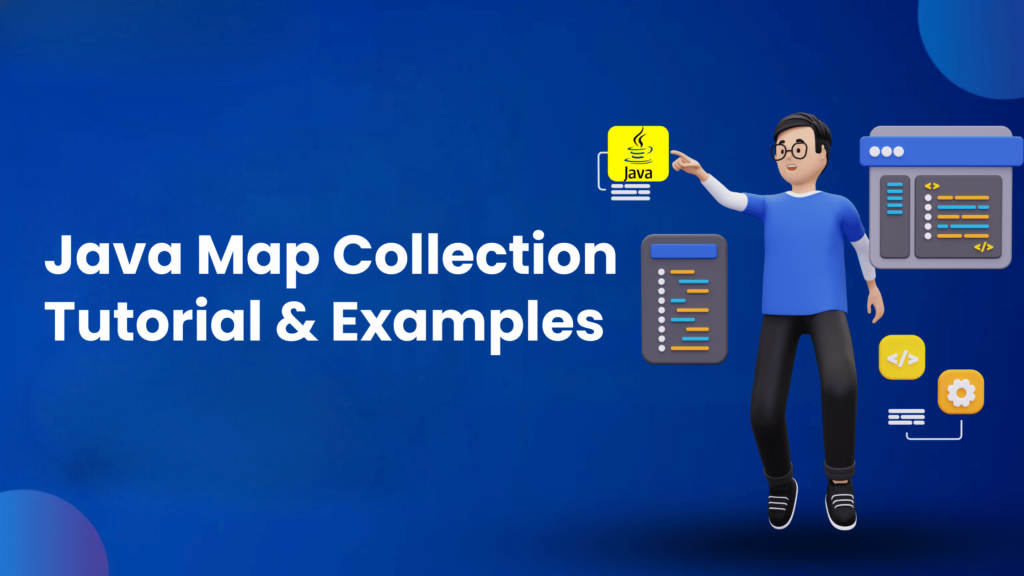
Java Map Collection Tutorial
Map stores the value in the form of key and value pair. A map cannot contain duplicate keys, Each key is associated with a single value.
Example:
- Mapping of Students name with their RollNo
- Mapping of Airport Nae with their Airport Code
- Mapping of Employee Name with their EmployeeId
Collection Framework:
- It is the set of Predefined classes & interfaces which is used to store multiple data.
- It contains 2 main parts(Packages):-
- java.util.Collection;
- java.util.Map;
Map Hierarchy in Java:

Collection Hierarchy in Java:
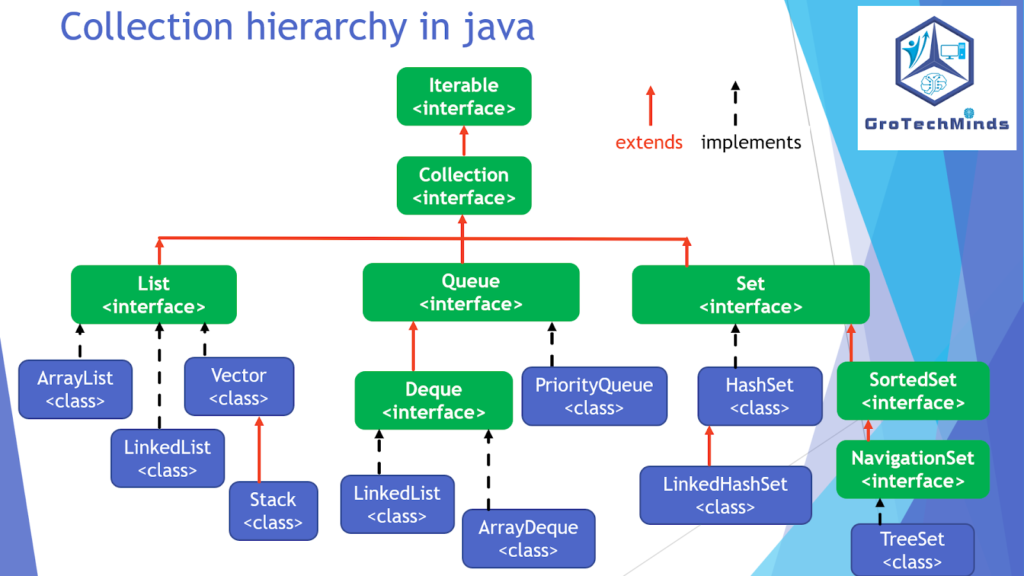
As a part of this blog we will keep our discussion only for Map Interface.
Below are the useful methods of MAP Interface:
| Method | Description |
| put(Object, Object) | Adds a new key: value pair to the map |
| putAll(Map) | Copies all the mappings of the specified map into the new map |
| size() | Returns the total number of key: value pairs in a map |
| clear() | Clears and removes all the mappings |
| equals(Object) | Checks the equality between two maps |
| containsKey(Object) | Returns a boolean value depending on whether the specified key is mapped or not |
| containsValue(Object) | Returns a boolean value depending on whether the specified value is mapped or not |
| get(Object) | Returns the value mapped with the specified key or null if the key is not mapped |
| isEmpty() | Checks whether the map is empty |
| keySet() | Returns a set view of the mapped keys |
| remove(Object) | Removes an element’s key mapping |
| value() | Creates a collection of the values of a map |
| putIfAbsent(Object key,Object value) | If the specified key is not already associated with a value (or is mapped to null) associates it with the given value and returns null, else returns the current value. |
| replace(Object Key,Object Oldvalue,Object NewValue) | Replaces the entry for the specified key only if currently mapped to the specified value |
| replace(Object key,Object value) | Replaces the entry for the specified key only if it is currently mapped to some value. |
package ab43;
import java.util.HashMap;
import java.util.Map;
public class Map_Interface
{
public static void main(String[] args)
{
Map m1=new HashMap();
//Upcasting HashMap to Map Interface
m1.put("student 1", "Manish");
//Adds a new key: value pair to the map
m1.put("student 2", "Abhishek");
m1.put("student 3", "Sunita");
m1.put("student 4", "Jeetu");
System.out.println(m1);
}
}
Output:
{student 3=Sunita, student 4=Jeetu, student 1=Manish, student 2=Abhishek}
Screenshot:

package ab43;
import java.util.HashMap;
import java.util.Map;
public class Map_Interface2
{
public static void main(String[] args)
{
Map m1=new HashMap();
m1.put("student 1", "Manish");
m1.put("student 2", "Abhishek");
m1.put("student 3", "Sunita");
m1.put("student 4", "Jeetu");
System.out.println(m1);
Map m2=new HashMap();
//Copies all the mappings of the m1map into the new map m2
m2.putAll(m1);
m2.put("Student 5", "Reeyansh");
System.out.println(m2);
}
}
Output:
{student 3=Sunita, student 4=Jeetu, student 1=Manish, student 2=Abhishek}
{student 3=Sunita, student 4=Jeetu, Student 5=Reeyansh, student 1=Manish, student 2=Abhishek}
Screenshot:
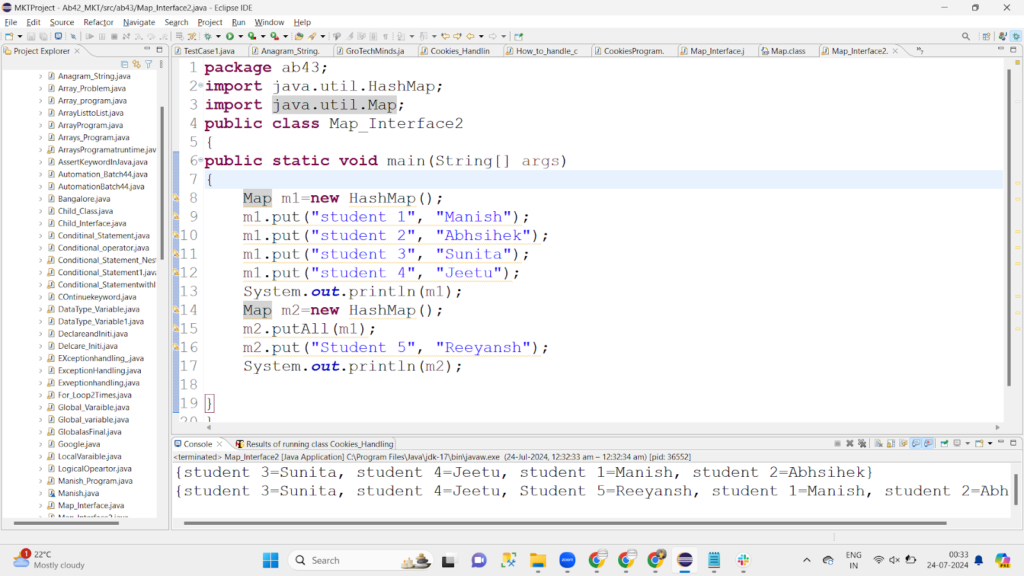
package ab43;
import java.util.HashMap;
import java.util.Map;
public class Map_Interface3
{
public static void main(String[] args)
{
Map m1=new HashMap();
m1.put("student 1", "Manish");
m1.put("student 2", "Abhishek");
m1.put("student 3", "Sunita");
m1.put("student 4", "Jeetu");
System.out.println(m1);
m1.clear();
//Clears and removes all the mappings
System.out.println(m1);
}
}
Output:
{student 3=Sunita, student 4=Jeetu, student 1=Manish, student 2=Abhishek}
{}
Screenshot:

package ab43;
import java.util.HashMap;
import java.util.Map;
public class Map_Interface4
{
public static void main(String[] args)
{
Map m1=new HashMap();
m1.put("student 1", "Manish");
m1.put("student 2", "Abhishek");
m1.put("student 3", "Sunita");
m1.put("student 4", "Jeetu");
System.out.println(m1);
Map m2=new HashMap();
m2.put("student 1", "Manish");
m2.put("student 2", "Abhishek");
m2.put("student 3", "Sunita");
m2.put("student 4", "Jeetu");
System.out.println(m2);
boolean a1= m1.equals(m2);
//Checks the equality between two maps
System.out.println(a1);
}
}
Output:
{student 3=Sunita, student 4=Jeetu, student 1=Manish, student 2=Abhishek}
{student 3=Sunita, student 4=Jeetu, student 1=Manish, student 2=Abhishek}
true
Screenshot:
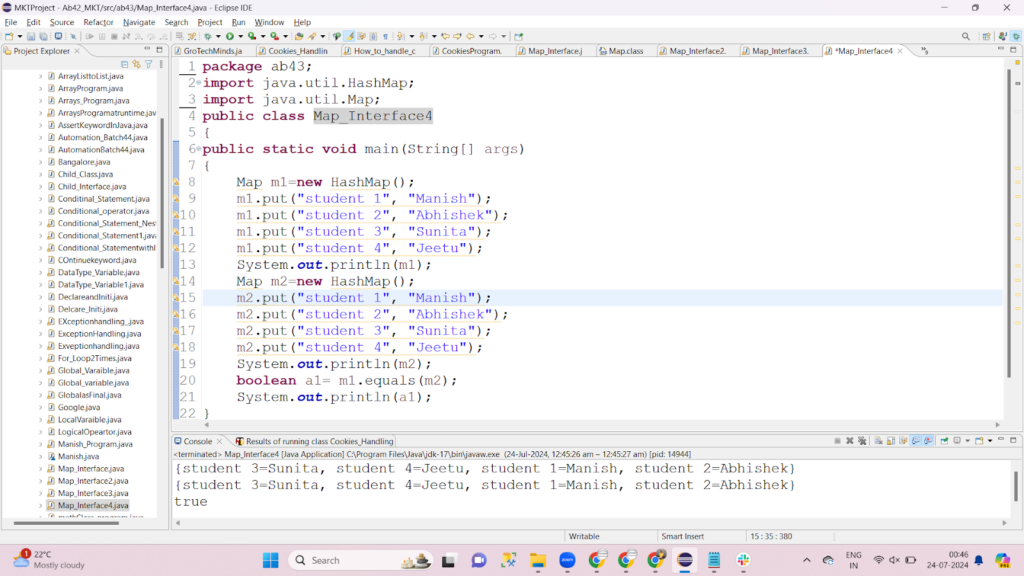
package ab43;
import java.util.HashMap;
import java.util.Map;
public class Map_Interface5
{
public static void main(String[] args)
{
Map m1=new HashMap();
m1.put("Rice",10);
m1.put("Sugar",2);
m1.put("Jaggery", 3);
m1.put("Cereals",25);
System.out.println(m1);
System.out.println(m1.get("Sugar"));
//Returns the value mapped with the specified key or null if the key is not mapped
}
}
Output:
{Cereals=25, Jaggery=3, Sugar=2, Rice=10}
2
Screenshot:
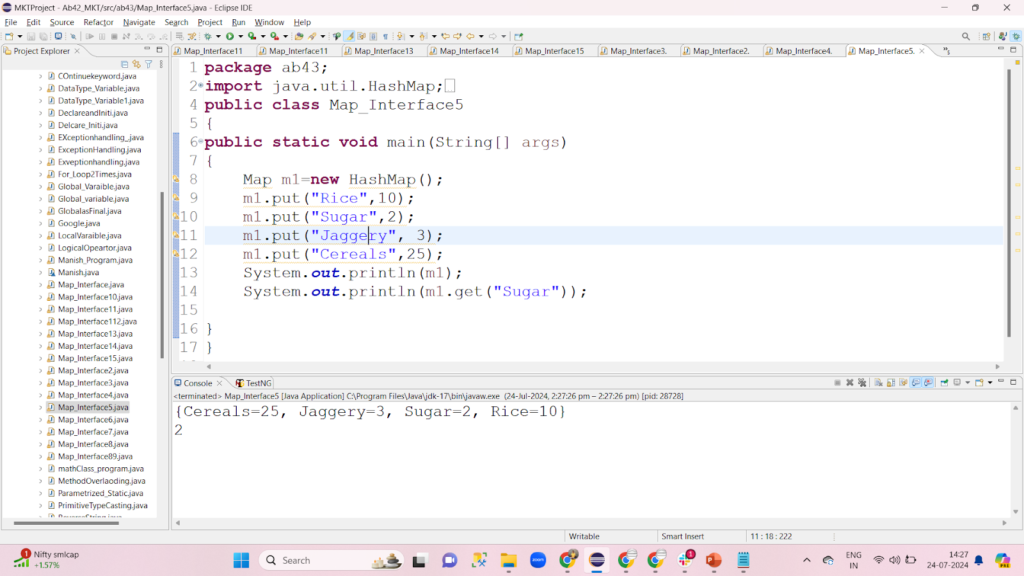
package ab43;
import java.util.HashMap;
import java.util.Map;
public class Map_Interface6
{
public static void main(String[] args)
{
Map m1=new HashMap();
m1.put("Rice",10);
m1.put("Sugar",2);
m1.put("Jaggery", 3);
m1.put("Cereals",25);
System.out.println(m1);
Map m2=new HashMap();
m2.putAll(m1);
System.out.println(m2);
m2.put("Oil", 5);
System.out.println("After Removing:");
m2.remove("Rice");
//Removes an element’s key mapping
System.out.println(m2);
}
}
Output:
{Cereals=25, Jaggery=3, Sugar=2, Rice=10}
{Jaggery=3, Cereals=25, Sugar=2, Rice=10}
After Removing:
{Jaggery=3, Cereals=25, Oil=5, Sugar=2}
Screenshot:
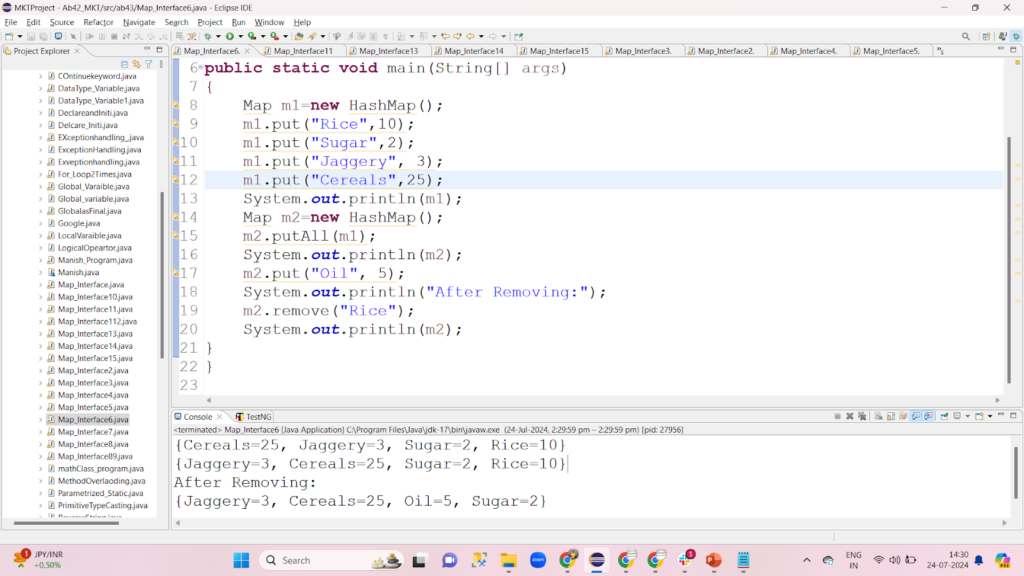
package ab43;
import java.util.HashMap;
import java.util.Map;
public class Map_Interface7
{
public static void main(String[] args)
{
Map m1=new HashMap();
m1.put("Rice",10);
m1.put("Sugar",2);
m1.put("Jaggery", 3);
m1.put("Cereals",25);
System.out.println(m1);
m1.replace("Rice", 90);
/Replaces the entry for the specified key only if it is currently mapped to some value.
System.out.println(m1);
}
}
Output:
{Cereals=25, Jaggery=3, Sugar=2, Rice=10}
{Cereals=25, Jaggery=3, Sugar=2, Rice=90}
Screenshot:
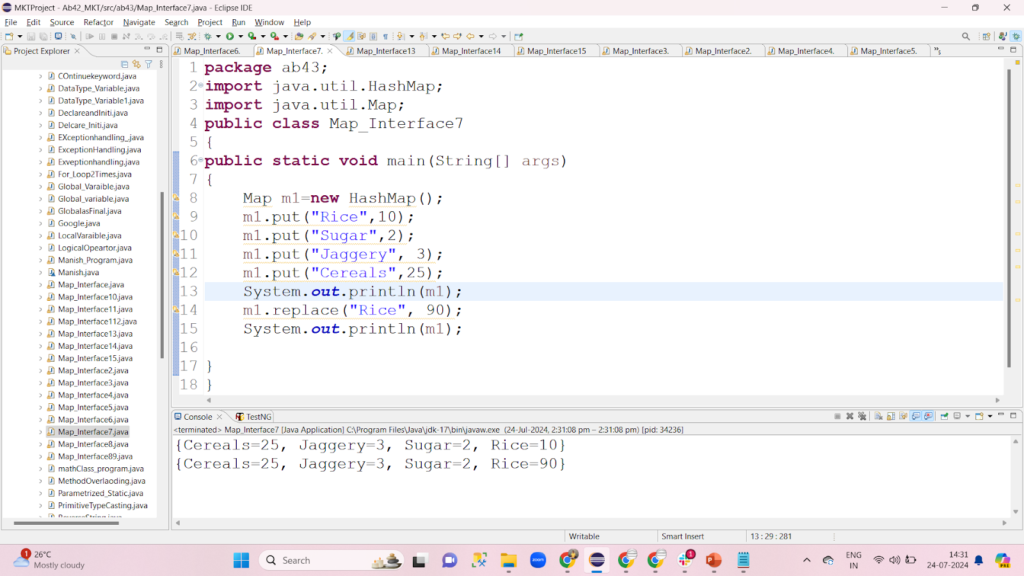
package ab43;
import java.util.HashMap;
import java.util.Map;
public class Map_Interface8
{
public static void main(String[] args)
{
Map m1=new HashMap();
m1.put("Rice",10);
m1.put("Sugar",2);
m1.put("Jaggery", 3);
m1.put("Cereals",25);
System.out.println(m1);
System.out.println(m1.size());
//Returns the total number of key: value pairs in a map
}
}
Output:
{Cereals=25, Jaggery=3, Sugar=2, Rice=10}
4
Screenshot:
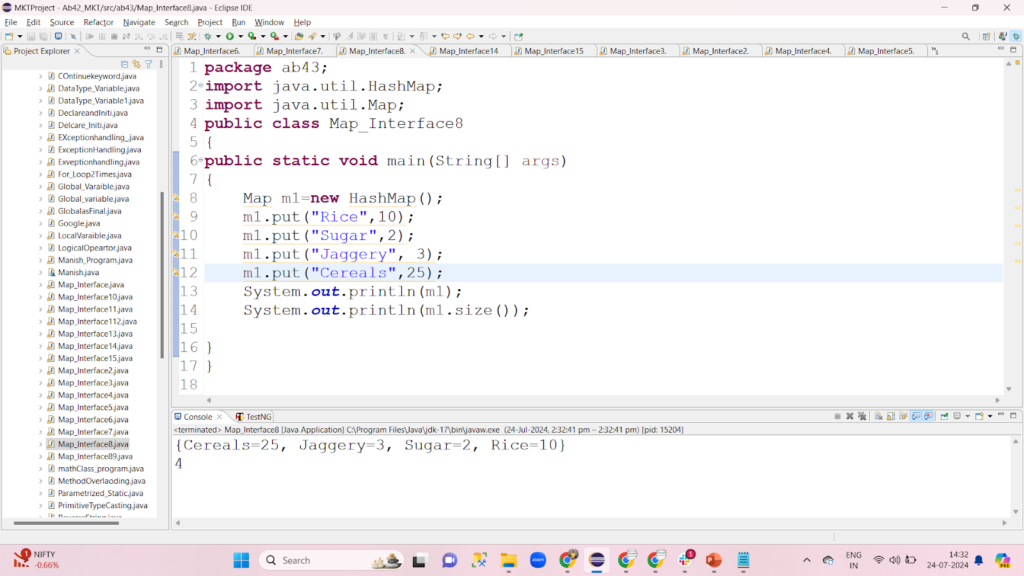
package ab43;
import java.util.HashMap;
import java.util.Map;
public class Map_Interface89
{
public static void main(String[] args) {
Map m1=new HashMap();
m1.put("Rice",10);
m1.put("Sugar",2);
m1.put("Jaggery", 3);
m1.put("Cereals",25);
System.out.println(m1);
System.out.println(m1.containsKey("Rice"));
//Returns a boolean value depending on whether the specified key is mapped or not
}
}
Output:
{Cereals=25, Jaggery=3, Sugar=2, Rice=10}
true
Screenshot:
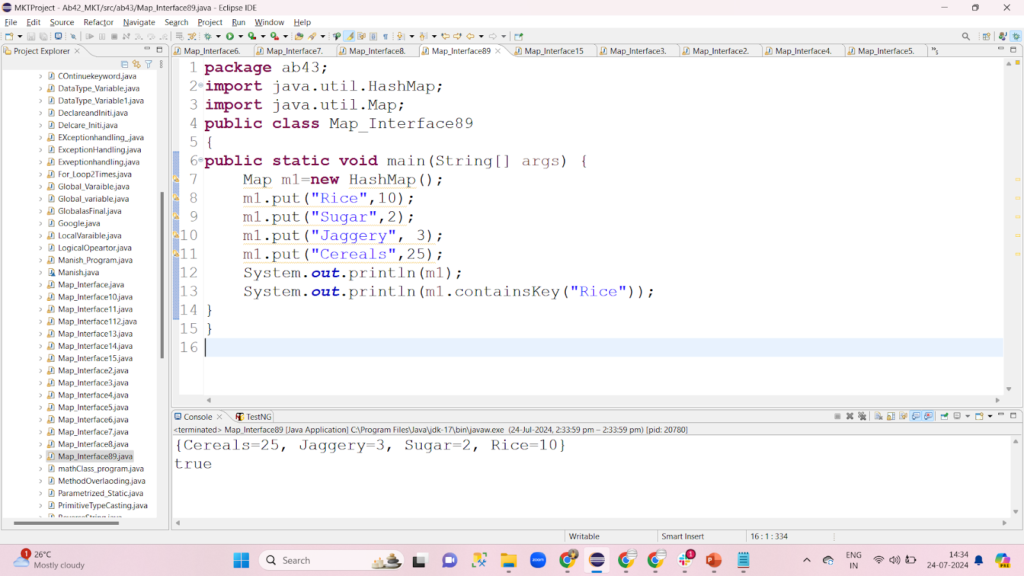
package ab43;
import java.util.HashMap;
import java.util.Map;
public class Map_Interface10
{
public static void main(String[] args)
{
Map m1=new HashMap();
m1.put("Rice",10);
m1.put("Sugar",2);
m1.put("Jaggery", 3);
m1.put("Cereals",25);
System.out.println(m1);
//Returns a boolean value depending on whether the specified value is mapped or not
System.out.println(m1.containsValue(2));
}
}
Output:
{Cereals=25, Jaggery=3, Sugar=2, Rice=10}
true
Screenshot:

package ab43;
import java.util.HashMap;
import java.util.Map;
public class Map_Interface11
{
public static void main(String[] args)
{
Map m1=new HashMap();
m1.put("Rice",10);
m1.put("Sugar",2);
m1.put("Jaggery", 3);
m1.put("Cereals",25);
System.out.println(m1);
m1.replace("Sugar", 2, 20);
//Replaces the entry for the specified key only if currently mapped to the specified value
System.out.println(m1);
}
}
Output:
{Cereals=25, Jaggery=3, Sugar=2, Rice=10}
{Cereals=25, Jaggery=3, Sugar=20, Rice=10}
Screenshot:
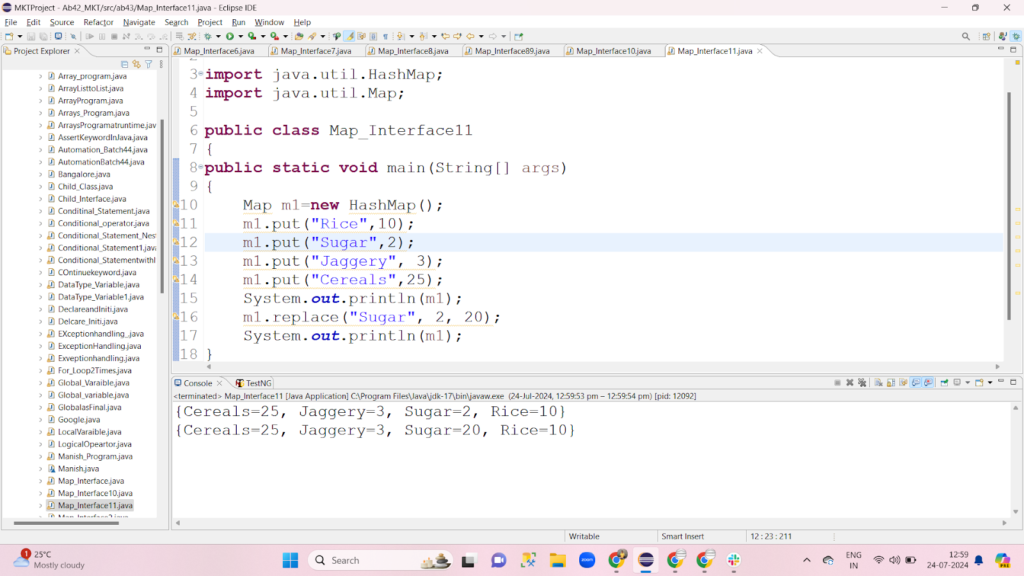
package ab43;
import java.util.HashMap;
import java.util.Map;
public class Map_Interface112
{
public static void main(String[] args)
{
Map m1=new HashMap();
m1.put("Rice",10);
m1.put("Sugar",2);
m1.put("Jaggery", 3);
m1.put("Cereals",25);
System.out.println(m1);
System.out.println(m1.values());
//Creates a collection of the values of a map
}
}
Output:
{Cereals=25, Jaggery=3, Sugar=2, Rice=10}
[25, 3, 2, 10]
Screenshot:
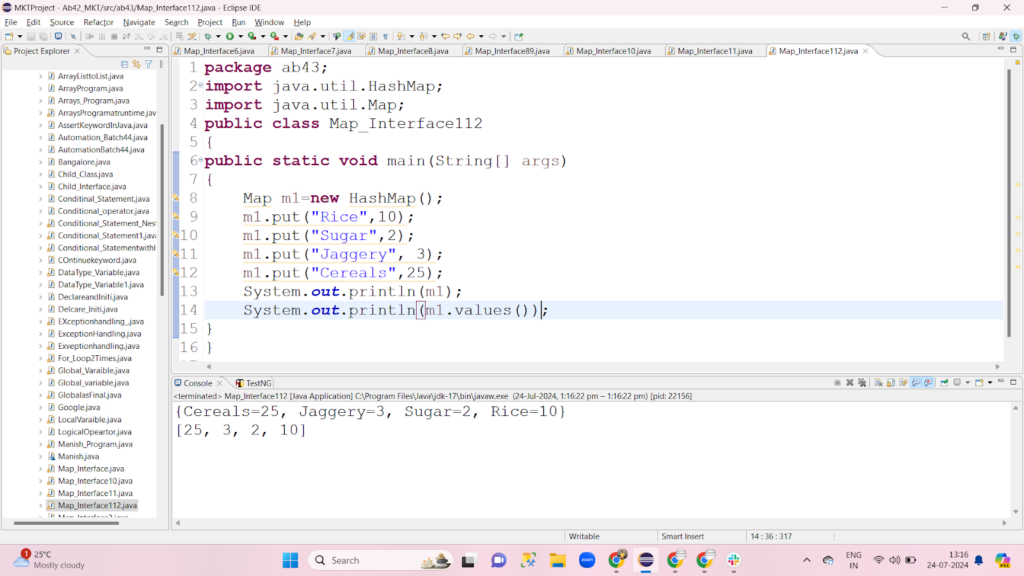
package ab43;
import java.util.HashMap;
import java.util.Map;
public class Map_Interface13
{
public static void main(String[] args)
{
Map m1=new HashMap();
m1.put("Rice",10);
m1.put("Sugar",2);
m1.put("Jaggery", 3);
m1.put("Cereals",25);
System.out.println(m1);
System.out.println(m1.keySet());
//Returns a set view of the mapped keys
}
}
Output:
{Cereals=25, Jaggery=3, Sugar=2, Rice=10}
[25, 3, 2, 10]
Screenshot:
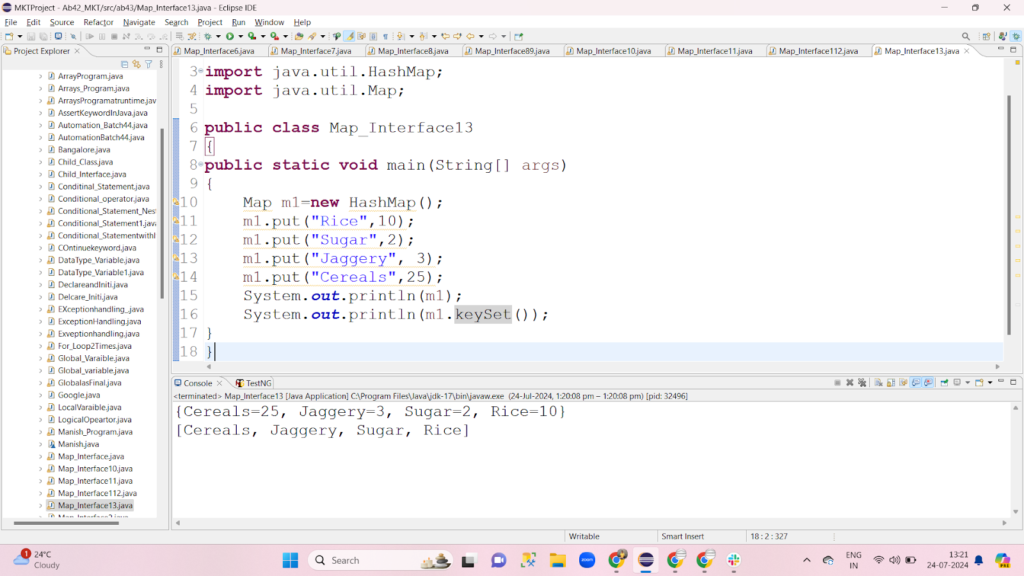
package ab43;
import java.util.HashMap;
import java.util.Map;
public class Map_Interface14
{
public static void main(String[] args)
{
Map m1=new HashMap();
m1.put("Rice",10);
m1.put("Sugar",2);
m1.put("Jaggery", 3);
m1.put("Cereals",25);
System.out.println(m1);
m1.putIfAbsent("Wheat", 100);
//If the specified key is not already associated with a value associates it with the given value
System.out.println(m1);
}
}
Output:
{Cereals=25, Jaggery=3, Sugar=2, Rice=10}
{Cereals=25, Jaggery=3, Wheat=100, Sugar=2, Rice=10}
Screenshot:
Example 1: Just because the “Wheat” key was not present it got added in m1.

Example 2: Just because the “Rice” key was already present it did not get added in m1.
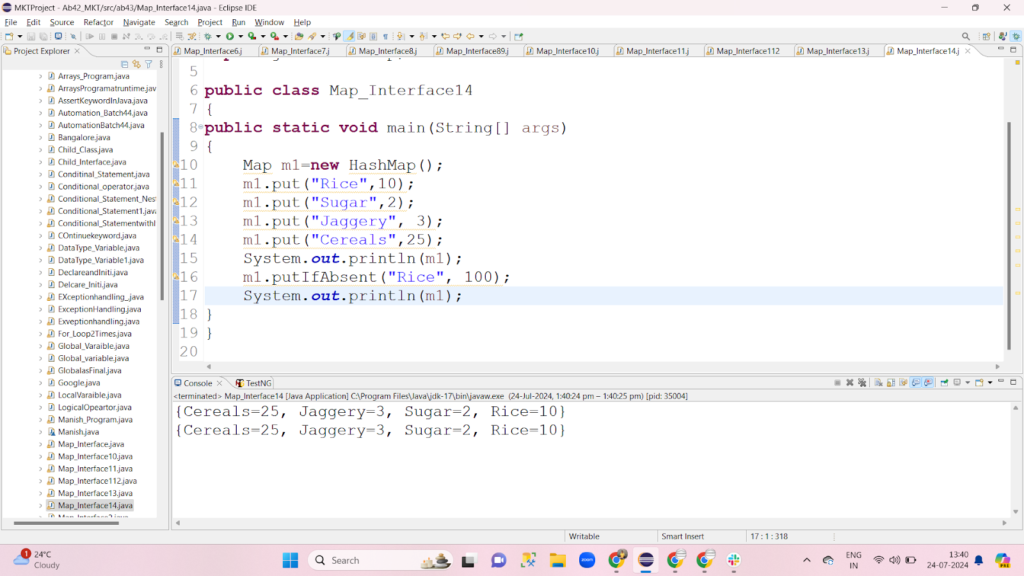
Case 1: Using EntrySet to fetch both key and value
package ab43;
import java.util.HashMap;
import java.util.Map;
import java.util.Map.Entry;
public class Map_Interface17
{
public static void main(String[] args)
{
Map<String,String> m1=new HashMap<String,String>();
//Upcasting from HashMap to Map Interface
m1.put("INR","Indian Rupee");
m1.put("USD","US Dollars");
m1.put("CAD", "Canadian Dollars");
m1.put("GBP","United Kingdom Pound");
//let's use for each loop to fetch key and value
//fetching both key and value using entryset method
for(Map.Entry<String,String> value1: m1.entrySet())
{
System.out.println(value1);
}
}
}
Output:
GBP=United Kingdom Pound
USD=US Dollars
CAD=Canadian Dollars
INR=Indian Rupee
Screenshot:
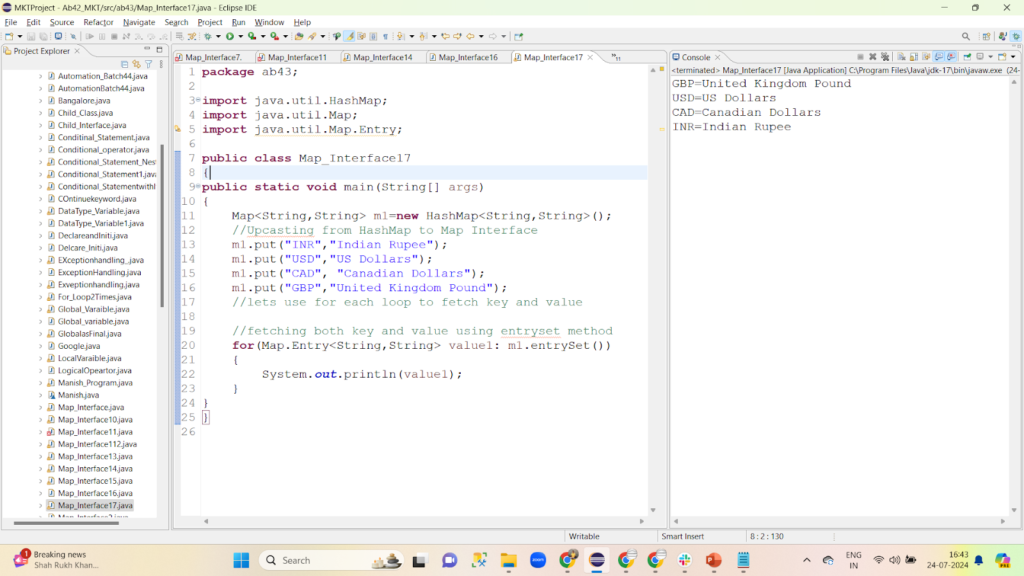
Case 2: Using keySet() to fetch only keys and using values() to fetch only values
package ab43;
import java.util.HashMap;
import java.util.Map;
import java.util.Map.Entry;
public class Map_Interface16
{
public static void main(String[] args) {
Map<String,Integer> m1=new HashMap<String,Integer>();
//Upcasting from HashMap to Map Interface
m1.put("Rice",10);
m1.put("Sugar",2);
m1.put("Jaggery", 3);
m1.put("Cereals",25);
//lets use for each loop to fetch key separately and value separately
for(String key: m1.keySet())
{
System.out.println("Keys-> "+key);
}
for(Integer value: m1.values())
{
System.out.println("Values-> "+value);
}
//fetching both key and value using entryset method
for(Entry<String, Integer> value1: m1.entrySet())
{
System.out.println("Key and Value -> "+value1);
}
}
}
Output:
Keys-> Cereals
Keys-> Jaggery
Keys-> Sugar
Keys-> Rice
Values-> 25
Values-> 3
Values-> 2
Values-> 10
Key and Value -> Cereals=25
Key and Value -> Jaggery=3
Key and Value -> Sugar=2
Key and Value -> Rice=10
Screenshot:
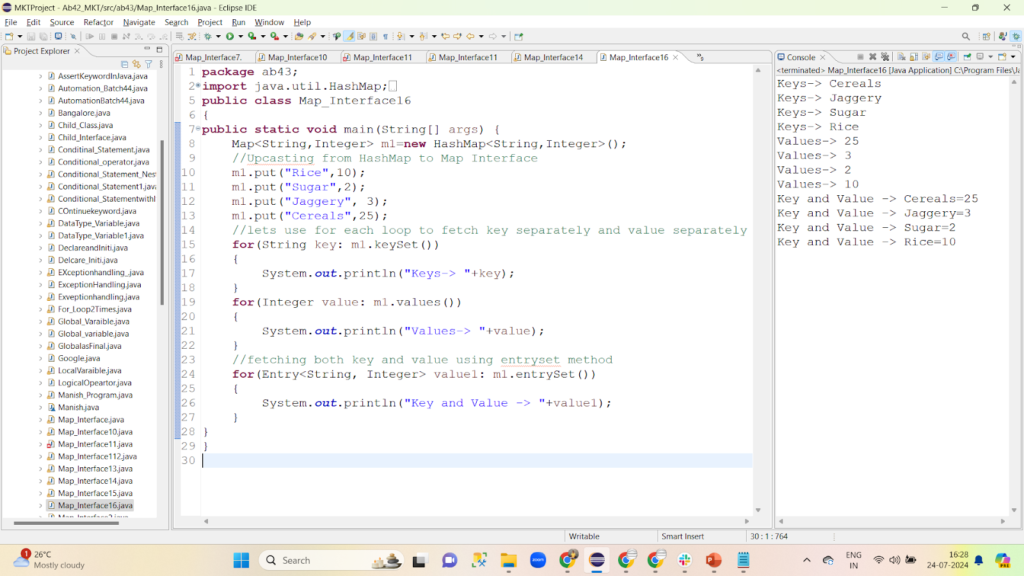
Case 3: Using Iterator to fetch both key and value together.
package ab43;
import java.util.HashMap;
import java.util.Iterator;
import java.util.Map;
import java.util.Map.Entry;
public class Map_Interface18
{
public static void main(String[] args)
{
Map<String,String> m1=new HashMap<String,String>();
//Upcasting from HashMap to Map Interface
m1.put("INR","Indian Rupee");
m1.put("USD","US Dollars");
m1.put("CAD", "Canadian Dollars");
m1.put("GBP","United Kingdom Pound");
Iterator<Entry<String, String>> i1=m1.entrySet().iterator();
while(i1.hasNext())
{
System.out.println(i1.next());
}
}
}
Output:
GBP=United Kingdom Pound
USD=US Dollars
CAD=Canadian Dollars
INR=Indian Rupee
Screenshot:

Now let’s discuss how List Set and Map Interface are different from each other:
| List | Set | Map | |
| Package | java.util.List | java.util.Set | java.util.Map |
| Duplicate | List allows you to store duplicate elements in java. | Set does not allow storing duplicate elements in java. | Map stores data in the form of key-value pairs; it does not allow to store duplicate keys but allows duplicate values in java. |
| Insertion Order | Maintain Insertion order | Does not maintain Insertion Order | Most of the Map classes do not maintain insertion order. |
| Null | List allows you to store many null keys in java. | Most of the Set implementations allow to add only one null in java | HashMap allows one null key and many null values. TreeMap doesn’t allow null keys but allows many null values. LinkedHashMap allows one null key and many null values. |
| Classes | List implementation classes are Array List, LinkedList. | Set implementation classes are HashSet, LinkedHashSet, and TreeSet. | Map implementation classes are HashMap, HashTable, TreeMap, WeakHashMap, and LinkedHashMap. |
| When to use | If you need to access the elements frequently by using the index then we can use the list | If you want to create a collection of unique elements then we can use set | If you want to store the data in the form of a key/value pair then we can use the map. |
| Traversing | We can traverse using Iterator and ListIterator | We can traverse using Iterator | It can’t be traverse but you can fetch using keyset(),value() and entrySet() |
Conclusion
Map in Java is an interface available in java. util package and it stores the data in key and value pairs. It does not allow duplicate keys. Each key is associated with a single value.Remember to practise, stay updated with the latest trends in Automation Software Testing Course,and maintain a positive attitude throughout your interview process.Automation testers can utlize all the methods of Map to create better and effective test scripts for automation testing of web applications and websites.
Also Read:
Consult Us


















